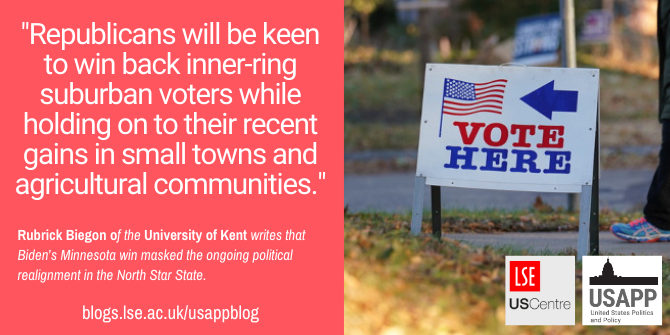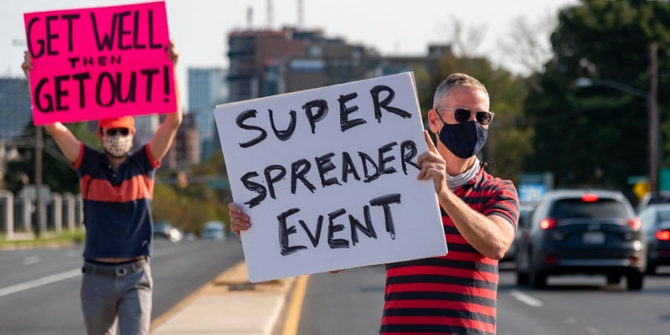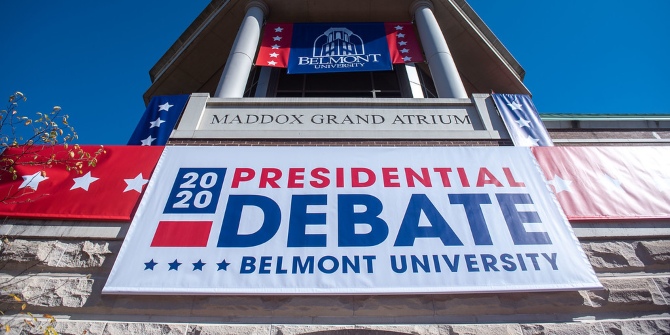 In 2020, Joe Biden won by a larger margin than Hilary Clinton did in the North Star State four years earlier. This victory, Rubrick Biegon argues, masks a larger political realignment between the state’s urban and rural communities that will keep Minnesota a particular shade of purple for the foreseeable future.
In 2020, Joe Biden won by a larger margin than Hilary Clinton did in the North Star State four years earlier. This victory, Rubrick Biegon argues, masks a larger political realignment between the state’s urban and rural communities that will keep Minnesota a particular shade of purple for the foreseeable future.
- Following the 2020 US General Election, our mini-series, ‘What Happened?’, explores aspects of elections at the presidential, Senate, House of Representative and state levels, and also reflects on what the election results will mean for US politics moving forward. If you are interested in contributing, please contact Rob Ledger (ledger@em.uni-frankfurt.de) or Peter Finn (finn@kingston.ac.uk).
In the early hours of November 4, when it became clear the result of the presidential election was closer than anticipated, Joe Biden took a relatively comfortable win in Minnesota. While Biden underperformed relative to pre-election polls in neighboring Wisconsin and Iowa, his lead held up in Minnesota, where he won by 7 percent. This exceeded Hilary Clinton’s 2016 margin, when Donald Trump came within 1.5 points of becoming the first Republican to win Minnesota since Richard Nixon.
As a newly-minted swing state, the ease of Biden’s victory in Minnesota suggested he had done just enough in the Midwest to stave off a second Trump shock. Minnesota is something of an outlier among the competitive ‘frostbelt’ states (which also include Michigan, Pennsylvania and Wisconsin), however. It recorded the highest voter turnout in the nation, with 80 percent of the eligible population casting ballots. Although it is one of the least-diverse states in terms of its racial composition, it has a highly educated population when measured by the number of residents holding college degrees.
Across the Upper Midwest and Great Lakes region, Democrats have consolidated their strength in urban communities while continuing to struggle in rural areas. This is consistent with the national picture. In relation to the urban-rural divide, there are emerging fault lines between the suburbs and the exurbs. As noted by the sociologist Mike Davis, although working-class (and formerly Democratic) communities have received more media attention, it is actually the wealthier exurban strongholds that constitute the core of the current Republican coalition.
Biden Dispatches Trump
Biden predictably dominated inner-ring suburbs around Minneapolis and St. Paul, winning Hennepin and Ramsey counties (the state’s most populous) by more than 40 percent. Trump was considerably more competitive in outer-ring suburbs, capturing exurban Anoka, Carver, and Scott counties by narrow margins. Biden improved on Clinton’s performance in suburban Washington and Dakota counties. Having lavished attention on the Iron Range, Trump failed to make strides in the northeastern corner of the state, home to mining districts and a dwindling population.
Biden’s win was hardly a surprise. Despite the Trump campaign’s efforts to flip Minnesota, recent history indicated this would be a tall order. Democrats have won every major statewide race since 2006, when Republican Tim Pawlenty was re-elected governor. Biden succeeded not only by running up the score in the metropolitan Twin Cities, but by cutting into Trump’s margins in rural areas relative to Clinton’s performance in 2016.
Down-Ballot Results and the Urban-Rural Divide
In the US Senate election, incumbent Democrat Tina Smith, who won a special election in 2018 after being appointed to fill Al Franken’s seat, defeated Republican challenger Jason Lewis. The margin was smaller than Biden’s victory. In a state that is behind the national curve when it comes to cannabis liberalization, the Senate contest saw candidates from two pro-cannabis parties win almost 8 percent of the combined vote. There is evidence that pro-pot candidates had ties to the GOP, which may have aimed to siphon votes from Democrats. Further down ballot, the presence of these minor parties likely swung control of the state Senate to Republicans.
Republicans gained one seat in the US House of Representatives. In western Minnesota’s seventh district, GOP challenger Michelle Fischbach defeated Rep. Collin Peterson, a conservative ‘Blue Dog’ Democrat and Chair of the Agriculture Committee. Incumbent Democratic Representatives Betty McCollum and Dean Phillips easily won reelection, as did Ilhan Omar, a high-profile member of the ‘squad’ of progressive Congresswomen. Republican incumbents Pete Stauber, Tom Emmer, and Jim Hagedorn also won reelection. In the 4-4 Congressional split, Democrats control the four House districts in the Twin Cities region, while Republicans represent the four more rural and exurban districts. As recently as 2016, however, Democrats held all three of Minnesota’s most rural Congressional districts.
As is the case nationally in the Senate and Electoral College, the urban-rural schism in Minnesota damages the ‘efficiency’ of the Democratic vote at the state level. While Democrats continue to be dominant in statewide elections, the concentration of Democratic voters in densely-populated constituencies means a higher degree of ‘wasted’ votes. This has produced years of divided government in St. Paul, the state capital. Following the 2020 results, Minnesota remained the only state in the nation with a split legislature, with the state Senate under Republican control and the lower house controlled by state Democrats.

“Vote Here sign in Minneapolis, Minnesota.” by Lorie Shaull is licensed under CC BY SA 2.0.
Context and Implications
Officially, the state’s Democrats are known as the Democratic-Farmer-Labor (DFL) Party; for many decades rural voters were a pillar of its broad-based coalition. This legacy may have delayed the impact of national trends in the state, where Democrats continued to be competitive in outlying areas well into the Obama presidency. As observed by the Minnesota Reformer, an independent news outlet: “Beginning in 2014 especially, the two parties’ geographic coalitions began to shift. Republicans began to rely more on rural white voters to build a majority while the DFL started winning white collar voters in the suburbs”. If Trump’s 2016 campaign accelerated this trend, Biden’s victory was based partly on ‘mean reversion’ in ‘Greater Minnesota’.
Minnesota’s demographics are changing. As of 2018, it had the highest number of refugees per capita of any state. Population growth is concentrated in the suburbs. This is likely to create some interesting dynamics in terms of redistricting. With divided government a persistent reality, the formation of new districts will likely be decided in the courts. Even through this more neutral approach, the bias toward drawing compact districts tends to reinforce the very dynamics that produce divided government.
There is no obvious, single explanation for Minnesota’s political realignment. It may be that cultural issues are the driving factor, but declining union membership in the outstate economy could also play a role. Political scientist Lawrence R. Jacobs has pointed to the interplay of diverging economic fortunes and rural resentment of ‘Minneapolis values’, exacerbated by a progressive language of ‘privilege’ that discounts rural experiences and needs. It could also be the case that the urban-rural divide, while real, is over-emphasized. Recent research reveals important concerns that transcend the purported gulf between city and country, from affordable housing and broadband access to the effects of an aging and diversifying population.
Nevertheless, when it comes to the forces structuring electoral politics in the North Star State, the basic outline is clear. Moving forward, Republicans will be keen to win back inner-ring suburban voters while holding on to their recent gains in small towns and agricultural communities. The DFL will make overtures to rural communities using economic appeals while attempting to reproduce their success in more affluent areas of the Twin Cities metropolitan region. Minnesota may remain a peculiar shade of purple for some time.
Please read our comments policy before commenting
Note: This article gives the views of the author, and not the position of USAPP– American Politics and Policy, nor of the London School of Economics.
Shortened URL for this post: https://bit.ly/3czf7gX
About the author
 Rubrick Biegon – University of Kent
Rubrick Biegon – University of Kent
Dr Rubrick Biegon is a Lecturer in International Relations at the University of Kent, where his research focuses on US foreign policy. His recent work has been published in Geopolitics, Global Affairs and International Relations, among other outlets. He was raised in St. Paul, Minnesota, and attended the University of Minnesota as a political science undergraduate.






